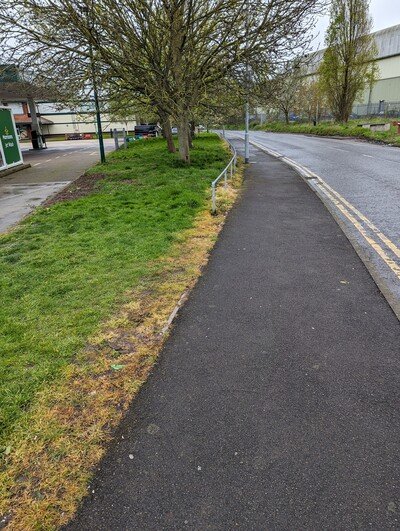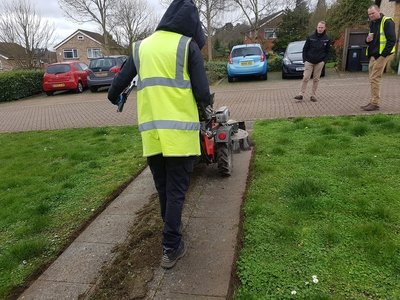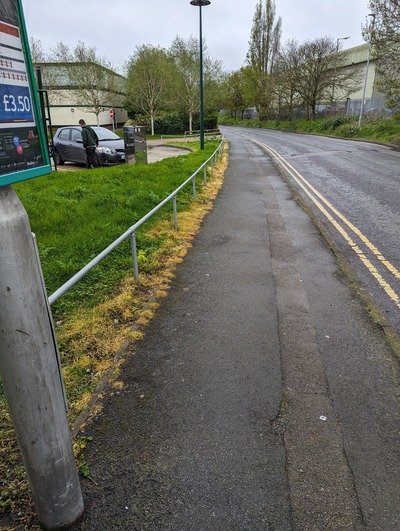What's wrong with using chemicals to edge paths?
Chemical edging is a fairly common practice in the UK. We have a law preventing blanket spraying of herbicides on hard surfaces, which I would like to suggest this practice contradicts.
Blanket spraying the path edge
In November 2011, the Health and Safety Executive issued Regulatory Update 42/2011, confirming the requirement for hard surface herbicide applications to be targeted. The following wording appears in the ‘directions for use’ section of all labels for hard surface approved products: “Apply this product carefully. Ensure spraying takes place only when weeds are actively growing (normally March to October) and is confined only to visible weeds including those in the 30cm swath covering the kerb edge and road gulley – do not overspray drains.”
So, what do we make of this picture?

Blanket sprayed path edge
Technically there is vegetation where they have sprayed, but being as the area is planted with grass, and there is an edge, presumably the grass was intended as a weed suppressant, amongst other benefits and is therefore not a weed, except the tiny bit that overspills the tarmac.
Since 2012, there has been "the obligation for users or those who cause or permit others to use pesticides to give preference to certain types of products and to minimise use (including in amenity areas)."
To me, NO attempt has been made here to minimise herbicide use. In fact, the exact opposite has happened. They have maximised herbicide use in order to save time or money on other jobs such as sweeping, strimming, or planting something that creates less detritus. This is completely against the spirit of the legislation, even if it is possible to argue that they haven't exceeded the limitations of the wording.
The impact of this is multifaceted.
- The grass which provides a valuable habitat for small animals, and is a prime sniffing area for people's dogs is wiped out. (A recent court case in the Highlands saw a man successfully winning cost of medical bills from Moray Council following the death of his dog, that was deemed to have been killed by weedkiller sprayed on the verge).
- There has been a lot of rain,making run off into the drains on the road much more likely.
- The soil overspilling the pavement will increase as the dead weeds decompose, allowing for more and deeper rooted weeds on the pavement next time.
- The soil is left there, allowing for freeze-thaw damage on the pavement and still impeding access and drainage if left there.
- Much more pesticide is used than is actually necessary to maintain the pavement (None is needed, as other methods could be used instead, but if it happend to be necessary, this is far more product than is needed to kill what is on the pavement .)

A weedbrush used for path edging
Instead of spraying; the weeds on the pavement could easily have been removed with a weedbrush. This would probably have taken less time than putting on the PPE and mixing the herbicide. it would have minimised the amount of habitat that is destroyed, whilst removing the soil from the pavement. It would have reduced the particulate matter on the pavement, reducing air polution and water pollution.

weedkiller used under railings
The weedkiller has also been used to weed under this railing. There are two obvious solutions which would be far better for the valuable habitat there. Strimming is the first and probably the most common. At least this would leave some of the vegetation under the railings for the small beasties to enjoy. Alternatively you could plant a weed suppressing cover crop such as creeping thyme, or even a mix of things to increase biodiversity and reduce detritus from strimming and other maintenance.
If you want help to end the practice of chemical edging in your area, check out our Integrated Weed Management solutions.
No comments yet. Login to start a new discussion Start a new discussion